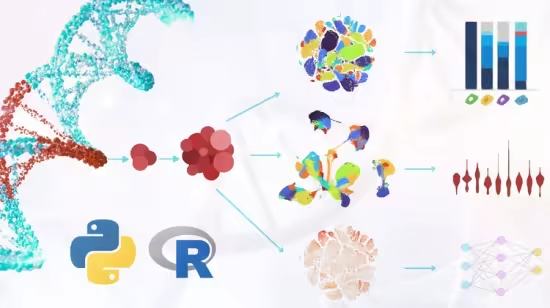
Published 6/2025
MP4 | Video: h264, 1280×720 | Audio: AAC, 44.1 KHz, 2 Ch
Language: English | Duration: 3h 57m | Size: 1.98 GB
Master Single-Cell RNA-seq Analysis from Scratch Using R, Python, and Cloud Tools — Master QC, Clustering and Annotation
What you’ll learn
Understand the principles of single-cell RNA sequencing (scRNA-seq) and how it differs from bulk RNA-seq.
Set up and use R and RStudio for bioinformatics workflows, including data import/export, visualization, and package management.
Perform quality control and normalization on single-cell RNA-seq data using Seurat in R.
Execute dimensionality reduction (PCA/UMAP) and clustering to identify distinct cell populations.
Identify marker genes and perform differential gene expression (DEG) analysis between clusters or conditions.
Use SingleR and reference datasets to annotate cell types in single-cell data.
Analyze scRNA-seq data in Python using Scanpy and scVI-tools, from preprocessing to cell type annotation.
Visualize scRNA-seq results with violin plots, PCA, UMAP, and volcano plots for publication-quality graphics.
Run GUI-based and cloud-based single-cell pipelines using platforms like Galaxy or CodeOcean without coding.
Confidently apply complete scRNA-seq pipelines on real-world datasets from GEO (NCBI) using R, Python, or GUI tools.
Requirements
No prior experience with single-cell RNA-seq is required – this course is designed for complete beginners and walks you through every concept from scratch.
Basic understanding of biology or genomics is helpful but not mandatory. We explain all necessary biological terms in a simple and practical way.
No prior coding experience needed – we will guide you step-by-step in using both R and Python for bioinformatics.
A computer with internet access (Windows, macOS, or Linux) is required to install R, RStudio, Python, and other free tools used in the course.
Willingness to learn and explore real-world biological data using modern bioinformatics tools.
(Optional) If you’re familiar with basic command-line usage or RNA-seq, it will make your journey faster—but again, not required!
Description
Are you interested in exploring the fascinating world of single-cell RNA sequencing (scRNA-seq) but don’t know where to begin? Whether you’re a biology student, a bioinformatics beginner, or a data science enthusiast, this course — “Master Single-Cell RNA-seq Data Analysis using R and Python” — is your complete, beginner-friendly guide to analyzing scRNA-seq data using modern bioinformatics techniques and open-source tools.What You’ll LearnThis comprehensive course is designed to introduce single-cell RNA sequencing step-by-step, from theoretical background to full-scale practical implementation. You will begin with an understanding of how scRNA-seq works, how it evolved from traditional bulk RNA-seq, and where it is used in modern biological and medical research such as cancer biology, immunology, neuroscience, and developmental biology.The course is divided into 5 sections:Section 1: Introduction to Single-Cell RNA-seqYou’ll start with the fundamentals:What is scRNA-seq?How it differs from bulk RNA-seq?Real-world applications of scRNA-seq in biomedical research.A complete overview of the scRNA-seq analysis pipeline, giving you clarity on each step from raw data to biological insights.Section 2: Learning R for BioinformaticsBefore jumping into real analysis, we prepare you with:An introduction to R programming for biologistsInstalling and configuring R and RStudioUnderstanding data structures like vectors, matrices, and data framesHow to import/export data, install packages, and generate beautiful visualizations — critical skills for any bioinformatics project.Section 3: scRNA-seq Data Analysis in RThis is the core of the course, where you:Install key libraries like Seurat, SingleR, celldexDownload and preprocess real scRNA-seq datasetsPerform Quality Control (QC) and normalizationReduce dimensionality using PCA, cluster cells, and run UMAP visualizationsIdentify marker genes, perform differential gene expression (DEG) analysis, and annotate cell typesAll analyses are done hands-on in R, with detailed walkthroughs.Section 4: Single-Cell RNA-seq Analysis in PythonIn this section, you’ll learn to use Python-based tools such as:ScanpyscVI-toolsHow to replicate the full analysis pipeline using PythonPerform advanced cell type annotation using scANVIThis enables you to become fluent in both R and Python-based workflows, increasing your versatility as a data analyst or researcher.Section 5: GUI and Cloud Pipelines for Non-CodersNot a programmer? No problem!You’ll learn how to:Run scRNA-seq analysis using Graphical User Interfaces (GUI)Use cloud platforms like Galaxy or CodeOceanAccess datasets from GEO and process them without writing codeWhy Take This Course?No prior coding experience needed — we’ll guide you step-by-stepCovers both R and Python pipelines, giving you flexibilityUses real datasets from NCBI GEO, making your learning practical and relevantIncludes GUI options for those who prefer visual toolsTaught by an instructor experienced in training bioinformatics students worldwideWho is this Course For?Beginners in bioinformatics or genomicsBiology students transitioning into computational biologyData scientists curious about single-cell transcriptomicsResearchers wanting to analyze their own scRNA-seq dataBy the end of this course, you will be confident in running complete scRNA-seq analyses, interpreting biological results, and even applying for roles or research positions requiring single-cell data skills.Join now to unlock the power of single-cell RNA-seq analysis — and take your bioinformatics journey to the next level using R, Python, and GUI-based tools!
Password/解压密码www.tbtos.com
转载请注明:0daytown » Learn Single-Cell RNA-seq Data Analysis using R and Python